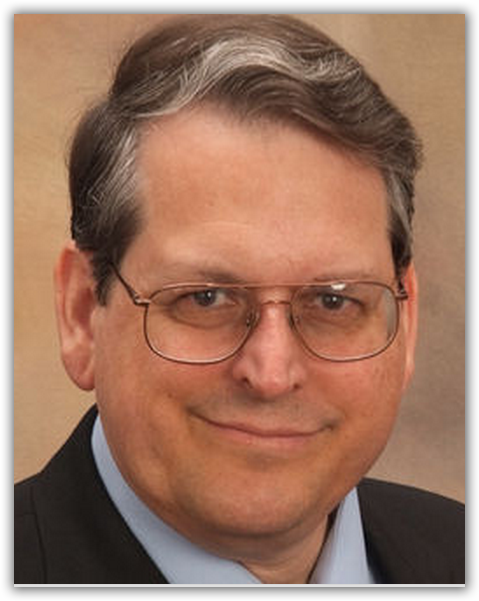aNewDomain  — Here’s our intrepid columnist Lamont Wood with a report from Flyover Country, USA.
— Here’s our intrepid columnist Lamont Wood with a report from Flyover Country, USA.
The weather reporter on the national news channel stands in the middle of the screen, over the middle of the US map, nattering on and on about where to see the most colorful autumn foliage in New England.
Her legs cover the part of the map where I live, aquí en la ciudad de San Antonio, Texas. Occasionally she shifts position slightly, so I can briefly glimpse my city on the map.
I notice there seems to be some kind of special map symbol there, perhaps a deaths-head or something. But her leg is covering that up, too. Hmm. Does it have some significance? Are we evacuating the city? Surely she would have said something…
The weather reporter shifts to a beach-cam in Los Angeles. Yes, in the past people there have been forced to wear sweaters. She continues standing over my city while she dwells on the enormity of the sweater-requirement tragedy. The symbol —maybe it’s a mushroom cloud? Or just a high-pressure marker?
She turns back to the East Coast, and talks about tides in New York, still standing in front of my city. In fact, she soon wraps up the weather segment without ever mentioning anything not on the East of West Coast. And I never do get to see what that symbol is—
–Then I get an e-mail from someone on the East Coast. A friend of a friend is reported to be in a specific hospital in my city with a serious condition. My correspondent is alarmed—that the sufferer is in a hospital in my city. I send an answer, assuring the questioner that the hospital is a first-rate, modern facility, with a trained staff, and does not resemble what he saw in the railroad depot field hospital scene in Gone With the Wind.
He seems relieved.
Welcome to life in Flyover Country, the territory between the coasts, known to those on the coasts for the way its inhabitants appear ant-like when viewed from cruising jumbo-jets, during a five-hour 2,700-mile flight from New York City to that other cultural center, Los Angeles.
That’s ironic, considering that any such traveler is leaving a scaled-up anthill, although, judging from photos, some of the suburbs appear habitable. Today’s geographers of urbanization refer to the environs of New York as the Northeast megacity. This megalopolis clings precariously to the coast from Norfolk, VA, to Portland, ME.
Flying west, our cultural expatriate will be skirting, to the north, the Great Lakes megacity, which these days stretches from St. Louis through Chicago and Detroit, to Toronto, with disconnected outliers to Kansas City and Minneapolis-St. Paul. (Some call this the Third Coast in deference to the lakes, but the lakes will be out of sight of our traveler, and therefore may as well not exist.)
Over the horizon to the south, and thus also out of mind, will be the (landlocked, despite the name) Piedmont-Atlantic megacity, stretching from Birmingham to Atlanta to Raleigh-Durham, with disconnected outliers in Memphis and Nashville.
Even further out of sight to the south, and therefore granted only the merest theoretical existence, is the Florida megacity.
About halfway through our flight our traveler will be skirting (but probably safely out of sight of) Oklahoma City, which is considered a disconnected outlier of the Texas Triangle (Houston, Dallas-Fort Worth, and San Antonio, constituting the bulk of the population of the Nation of Texas.) Actually, it could also be considered an outlier of the Great Lakes megacity, so the time may come when Oklahoma City has to choose—assuming it survives being in Tornado Alley.
Beyond the Texas Triangle to the south is the Gulf Coast, from Brownsville on the Mexico border to Pensacola. Houston is part of both the Gulf Coast and the Texas Triangle, giving it a unique dual identity—a fact of no interest to our traveler, of course.
Soon, our traveler passes 99 West Longitude, where precipitation falls off, discouraging the establishment of sprawling megacities. Nevertheless, there is a modest line of urbanization between Denver to Albuquerque (called the Front Range) with outliers around El Paso, and then outposts of urbanization in Phoenix-Tucson corridor, around Salt Lake City, and Boise.
Finally, nearly fainting from cultural deprivation, our traveler gets to the West Coast, which geographers divide into the megacities of Southern California (LA, San Diego, and for lack of anyone claiming it, Las Vegas) Northern California (San Francisco, etc.—although it looks on the map suspiciously like Central California) and Cascadia (Seattle to Portland.)
In Los Angeles, our traveler can soak up culture, marveling at how the place resembles the background of Hollywood movies and TV shows (since it is), or perhaps walk along the beach in a sweater.
Back in Flyover Country, I’ve dialed to the local channel, and the announcer actually stands to one side of the map—and calmly notes that the mysterious objects showing up on the local weather radar are clouds of bats on an evening feeding frenzy.
Maybe that explains the death symbol.
Reporting from Flyover Country for aNewDomain, I’m Lamont Wood.
Based in San Antonio, Lamont Wood is a senior editor at aNewDomain. He’s been covering tech trade and mainstream publications for almost three decades now. And he’s a household name in Hong Kong and China. His tech reporting has appeared in innumerable tech journals, including the original BYTE (est. 1975). Follow him @LamontWood.













